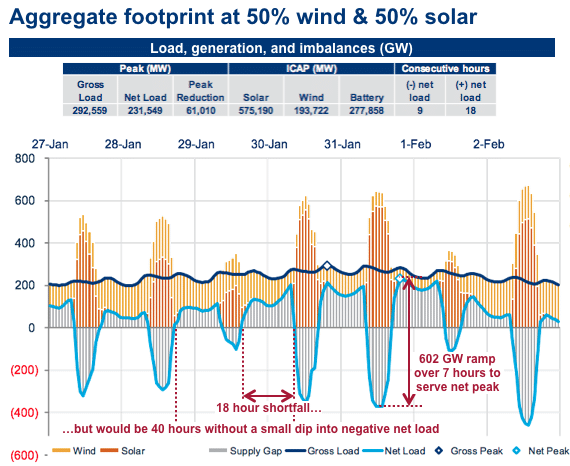The ambition represented by clean energy targets being set by state and federal policymakers has increased dramatically over the last two decades. While the first wave of renewable portfolio standard (RPS) policies focused on getting states to a minority portion of electricity from renewables, with 25% by 2025 being a common goal, now an increasing number of politicians are calling for 100% zero-carbon electricity, with six states adopting a version of this mandate.
And as this happens, the timelines for these mandates is also getting more aggressive. While the states that have passed 100% clean energy targets are aiming for the 2045 or 2050 timeframe, Washington D.C. is planning to move to 100% renewable energy by 2032.
Even more aggressive is U.S. Representative Alexandria Ocasio Cortez’ (D-New York) Green New Deal resolution, which would have the nation move to 100% renewable energy in electricity by 2030. But today, U.S. Presidential Candidate Bernie Sanders (D-Vermont) one-upped even that, saying that his administration would target 100% renewable electricity by 2030 as well as full decarbonization of transportation under his version of the Green New Deal.
100% renewables and nuclear power
The 100% renewables goal in both versions of the Green New Deal has some key differences from the 100% zero-carbon electricity mandates that have been passed by five states. Chiefly, the Sanders campaign says that his plan does not rely on what they describe as “false solutions” including nuclear power, geoengineering, carbon capture and sequestration, or trash incinerators.
This is not the first time that such a target has been proposed, and 100% renewable energy has been widely debated ever since a team led by Stanford Professor Mark Z. Jacobson first introduced a plan to move the world to 100% renewable energy in 2009.
Much of the criticism has come from supporters of nuclear power, including nuclear trade groups and academic institutions with strong ties to the nuclear industry. But despite an immense volume of anti-renewable arguments and as well as attacks on Jacobson’s modeling from within the scientific community, an increasing body of scholarship is supporting the feasibility for a switch to 100% renewable energy.
This is a very complicated and speculative matter, but one of the chief concerns is cost. Jacobson has referenced the economic mobilization that which the United States undertook during the Second World War, which led to critiques that his plan was impractical due to the cost and technical difficulty as renewable energy levels approach 100%.
Hydro and other solutions
In terms of pv magazine’s own research on this matter, we cannot stress enough how geographically specific the transition to very high levels of renewable energy is. While regions like the West Coast and Mountain West may have an easier time getting closer to 100% renewable energy due to the ample hydroelectric power in the Pacific Northwest, this may require additional transmission, and substantial changes to market rules and probably even governance structures would be necessary.
For the U.S. East Cost the most straightforward path would be to balance the variability of wind in the winter with hydroelectric power from Canada. This in turn would require a transmission build-out, and this has not been going too well to date, as NIMBYs backed by conservationist non-profits have stopped at least two major transmission projects in New England over the past few years.
For the U.S. Midwest and Plains States, the problem is even greater, as the bulk of hydroelectric capacity in North America is far from this region. In its modeling of the potential for high levels of renewable energy based on existing generation profiles during a cold snap last winter, Wood Mackenzie found a need for 40 hours of energy storage – as well as a 602 GW evening ramp – at 50% wind and 50% solar.

It is notable that Wood Mackenzie did not attempt to find the ideal mix of wind and solar, as other studies have done. And in theory this could be met by immense volumes of batteries and imports of power. EV charging stations and vehicle-to-grid capabilities could also play a big role but only if properly designed and coordinated.
It is important to note here that in his work Stanford Professor Mark Z. Jacobson stresses the synergies of decarbonizing the transportation, heating and other sectors, as these can serve as sources of flexible demand. However, fully decarbonizing transportation in only 10 years would mean not only moving the entire vehicle fleet over to electric power, but also removing all internal combustion engines off the road. This will be expensive – particularly in terms of complying with Sander’s stated aim that “no one is priced out of this transition”.
In general, doing all of this together in one decade would require changes much more rapid than anything we’ve seen to date, and the lack of widely deployed long-duration energy storage solutions other than pumped hydro – which is not widely available in the Midwest – paints a very challenging picture.
Wood Mackenzie also found that the need for these incredibly massive volumes of batteries and/or electric imports was lessened by the region’s existing nuclear fleet, which provides power during periods of low wind and solar. However, like other versions of the Green New Deal Sander’s plan does not directly address the existing nuclear fleet, meaning that the are some big technical questions as to how this move to 100% sustainable energy would play out under the societal requirement for stable electric supply.
Who will pay for it, and how?
The price tag for this move is not small: $16.3 trillion in public investment. This translates to $1.6 trillion annually up to the 2030 goal, which is more than the federal government’s entire discretionary spending in 2018. Like Jacobson, the Sanders Campaign invokes the mobilization of resources made during the New Deal and World War II.
The Campaign also says that this effort will pay for itself through a variety of means over 15 years including making the fossil fuel industry pay for its pollution and eliminating subsidies, collecting revenue from the sale of electricity, scaling back military spending, reduced need for federal and safety net spending, and “making the wealthy and large corporations pay their fair share”.
Some of these are likely to do more heavy lifting than others. Other aspects of the Sanders plan like an increased minimum wage and the 20 million jobs that this program would ostensibly create could eliminate the need for most safety net programs. However other than Medicare and SSI (which would remain and/or be expanded), SNAP and TANF are the two largest safety net programs, and together represent combined annual federal spending of less than $100 billion.
Furthermore, if fossil fuels are phased out, eliminating their subsidies is not likely to put more money in the federal government – although plans to fine such corporations could yield more. Two more likely sources of these funds would be increased taxes and reduced military spending. But even if we spread the $16.5 trillion in this plan over 15 years it still comes out to $1.1 trillion per year, which is still double the roughly $600 billion in discretionary funding which is going to the military.
In the end there are many questions as to how all of this would actually play out. But it must be considered that to date, the biggest problem that the U.S. federal government has had has not been excessive ambition on climate and clean energy issues.
This content is protected by copyright and may not be reused. If you want to cooperate with us and would like to reuse some of our content, please contact: editors@pv-magazine.com.









A terrible plan with a stupidly high price tag that will only drive people away.
Fact is done right, switching to RE will cost less, not more than FF generation.
And a doable goal is 75% by 2030 and 100% by 2036 or so. It isn’t faster because it’ll take that long to build, install the equipment, etc to make it happen.
As for storage since much of it is heating, cooling, thermal storage takes care of a lot of it cheaply, especially if it is CHP with a low temp generator working off heat storage too
Next is CHP is already huge in bigger buildings, farms, etc and will only get more so, filling in the gaps.
And as always not mentioning the biggest generation, storage sources, homes, buildings, EVs with V2G in just 10 yrs as so cheap and making 50-100% ROI/yr for 20 yrs, 50% of present loads will become on demand generators, again supplying on demand power.
And solar will be the key as can be used near everywhere and getting so cheap it pays very well..
“A terrible plan with a stupidly high price tag that will only drive people away.”
Where would they go? Into the rising ocean? Into flood waters? Into the parched deserts?
Simple math dictates Canada is not an option for (the Eastern US).
Canada is on tract to supply 100 TWH/yr to the US. Best case scenario, 50% is via Quebec, with smaller portions from Ontario Nuclear.
So 50 TWH/yr against 60+ % of US overall production of 4,200 TWh/yr.
This assumes [wrongly] Canada has decarbonized its sectors. It has not.
From both a solar and wind availability perspective, the eastern US is very much comparable (albeit much larger) then Germany, yet Germany has on the order of 2x the wind and solar deployed.
To a large degree, WoodMac is defending BAU in the Great Plains, specifically MISO and it’s G&Ts with no/little fast ramping capacity. Not surprisingly, based on past ‘events’ it is worth noting MISO (particularly MISO North) has the highest quantity & capacity of BTM generators (diesel backup) it calls up for DR – Demand Response.
The Great Plains are going to fair far better then most give them credit for, once we disaggregate leadership being exhibited by the likes of Xcel, Iowa, SwPP & ERCOT.
Our focus should be in enabling the often ‘captured’ Coops under the ‘bad actors’. Not all are willing/forwards thinking, but not all are ‘evil’ IOUs either, but most are broadbrushed as being so.
I don’t think you read the part about the East Coast & Canada carefully, and that is some really strange math.
First: This is not about what Canada is supplying now. It is what Canada could supply if there were greater electrical interconnection and integration of electricity markets.
Second: 60% of U.S. power? Where did that number come from? New England, New York, New Jersey and Pennsylvania total 17% of the U.S. population.
Third: Balancing the output of wind is more about capacity as opposed to energy. Hydro-Québec alone has a fleet of 36 GW of hydro plants, and that could significantly help New England and New York during the winter under high penetrations of renewable energy.
In terms of your pro-IOU arguments, that is totally not relevant to this article, and we’ve been down this road before.